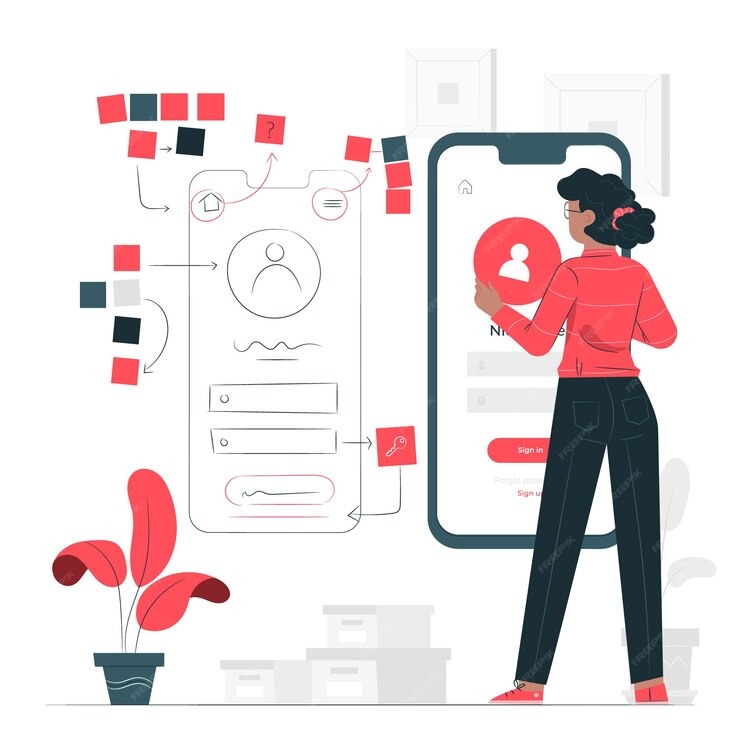#Learn UX & UI Design, #UI UX Beginner Guide, #UX design & UI Design
What is the Design Thinking Process
UX Design - Mentor & Author.
15 Nov, 2023

In recent years, UX design has gained significant recognition, attracting numerous designers to the field. The initial step in mastering UX design involves understanding the design thinking process that designers employ to address problems. In this article, we will explore the process. Let’s get started.
Empathize: Design Thinking Process
The Empathize stage is the initial phase of the design thinking process. During this stage, designers seek to gain a deep understanding of the users and their needs through comprehensive research. This research involves both qualitative and quantitative methods:

Qualitative Research: Design Thinking Process
User Interviews: Conduct one-on-one interviews with users to explore their experiences, preferences, and pain points. Qualitative interviews allow for in-depth conversations and the discovery of valuable insights.
Observations: Observe users as they interact with products or services in their natural environment. This method helps designers understand how users engage with the existing systems and identify areas for improvement.
Contextual Inquiry: Participate in users’ daily activities to gain a holistic understanding of their tasks and challenges. Contextual inquiry provides a deep, firsthand view of the user’s context.
Quantitative Research:
Surveys: Distribute surveys to a larger user base to collect structured, quantitative data. Surveys help designers gather statistical insights into user demographics, preferences, and behaviors.
Analytics Data: Examine existing data, such as website or app analytics, to identify user patterns, traffic sources, and areas of concern. Analytics data offers quantitative evidence of user interactions.
From this, designers can form an understanding of their users. This stage helps them uncover user needs, pain points, and behaviors, which serve as the foundation for making informed design decisions in the subsequent phases of the process.
Define:
The Define stage is the second phase of the design thinking process, following the Empathize stage. In this stage, the insights gained from user research are synthesized and transformed into practical tools that guide the design process. Here are the key components of the Define stage:
User Persona Development: Once the research is complete, designers create user personas. User personas are detailed, semi-fictional profiles that represent different segments of the target audience.
Empathy Maps: Designers often use empathy maps to synthesize the data from user research. These maps help visualize the users’ thoughts, feelings, actions, and pain points.
User Journey Mapping: This visual representation of the user’s interactions with a product or service helps identify key touchpoints and emotional states throughout their experience.
Ideate:
The Ideate stage is the third phase in the design thinking process, following the Empathize and Define stages. It’s a creative and collaborative phase where designers and cross-functional teams brainstorm, generate ideas, and explore potential solutions to address the user’s needs and the defined problem. Here’s a deeper look into what happens during the Ideate stage:
Information Architecture: Information architecture (IA) is the process of organizing and structuring information within a system to enhance user navigation and comprehension. It includes elements like sitemaps, taxonomies, and navigation menus.
Card Sorting: Card sorting is a user research technique where participants categorize and organize content or features based on their mental models. It aids in creating intuitive navigation and menu designs, with options for open and closed card sorting.
User Flow: User flow maps the path users take through a system to achieve specific goals. It’s depicted as step-by-step interactions, helping designers identify and optimize user journeys.
Task Flow: Task flow focuses on the detailed steps and interactions required to complete specific tasks within a system. It provides insights into the micro-interactions and decisions users make for particular objectives.
Prototype:
The Prototype step is a critical phase in the design thinking process where designers create a tangible and interactive representation of the product or interface they are designing. It’s essentially a working model that allows stakeholders to visualize and interact with the design concept. Here’s a more detailed breakdown of the Prototype step:

Wireframes:
Wireframes are a fundamental component of the prototype. They are low-fidelity, basic representations of the user interface. Wireframes focus on the layout, structure, and placement of elements without detailing the visual design. Wireframes are particularly useful in the early stages of prototyping to establish the overall information hierarchy and layout.
Fidelity Levels: Prototypes can have different levels of fidelity, ranging from low-fidelity to high-fidelity:
Low-Fidelity Prototypes: These are basic, often hand-drawn sketches or wireframes. They are quick and inexpensive to create and are used primarily to test concepts and ideas.
Medium-Fidelity Prototypes: These prototypes add more detail and visual elements to provide a better sense of the user interface. They are suitable for testing the overall flow and interactions.
High-Fidelity Prototypes: These closely resemble the final product in terms of visual design, interactions, and functionality. High-fidelity prototypes are used for in-depth usability testing and stakeholder presentations.
Testing:
The Testing step is a crucial phase in the design thinking process where the design concept is rigorously evaluated and validated through real-world user interactions. This step involves gathering feedback, identifying issues, and making iterative improvements to ensure the final product delivers an exceptional user experience. Here’s a more detailed breakdown of the Testing step:
User-Centric Evaluation: During this phase, real users, representing the target audience, actively engage with the product or interface. Their actions and feedback become the foundation for assessing and enhancing the user experience.
Usability Testing: Usability testing is a key component, focusing on task-based assessments. Users are given specific tasks to complete using the product, revealing how effectively they can achieve their goals and uncovering any usability challenges.
Accessibility Testing: Accessibility testing evaluates whether the design complies with standards and guidelines to make the product usable by individuals with disabilities.
Feedback Collection: User feedback is actively solicited through surveys, questionnaires, and interviews. These methods provide valuable insights into user satisfaction, pain points, and suggestions for improvement.
Conclusion
By now, you should understand what the design thinking process is and how designers apply it to address user problems. However, it’s crucial not to view this process as a one-way street; it’s more like a continuous cycle. Designers often revisit and repeat certain steps, returning to defining or prototyping after testing to implement necessary changes. When you’re tackling a problem, always keep the user in mind and never skip any step in this process. Ensure that the user remains a central focus throughout. Happy designing!


